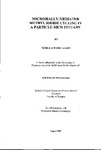MICROBIALLY-MEDIATED METHYL IODIDE CYCLING IN A PARTICLE-RICH ESTUARY
| dc.contributor.author | ASARE, NOBLE KWAME | |
| dc.contributor.other | Faculty of Science and Engineering | en_US |
| dc.date.accessioned | 2013-11-05T13:16:43Z | |
| dc.date.available | 2013-11-05T13:16:43Z | |
| dc.date.issued | 2007 | |
| dc.identifier | NOT AVAILABLE | en_US |
| dc.identifier.uri | http://hdl.handle.net/10026.1/2611 | |
| dc.description.abstract |
The dynamics of aquatic systems (e.g. estuarine systems) are known to facilitate the formation of particle aggregates. These nutrient-rich particulate matter provide suitable substrate for bacteria colonization. Although bacteria-aggregate association is known to result in the degradation of particulate organic matter (POM) in aquatic systems, it has never been attributed to the production of methyl iodide (CH3I) (an environmentally important biogas that has the potential to impact on atmospheric chemistry). From literature, there are evidences which suggest that, certain bacteria (methylotrophs) are capable of oxidizing methyl halides including CH3I. Therefore this study investigates microbial production and removal of CH3I in estuarine water through their association with aggregates and assesses the effect of physicochemical variables on bacterial-mediated production and removal of CH3I. From the study, bacteria-aggregate processes were found to elevate the concentration of CH3I between 15-22% of the total observed CH3I concentration over the study period. Aggregate-attached bacteria which were estimated to represent about 17% of the total bacteria population were responsible for about 37% of the overall bacterial activity. To investigate bacterial-mediated removal of CH3I in estuarine systems, a reliable and reproducible method through adaptations and modifications of existing methods was developed. This method involved the use of [14C] radiolabelled CH3I to estimate bacterial utilization of CH3I. The application of the method confirmed the removal of CH3I by methylotrophs in estuarine water with the total recorded amount in bacterial cells and oxidized C02 ranging between 9.3 - 24.5% (depending on the amount of the added substrate). However, this could only represent the potential microbial CH3I removal in the natural aquatic environment. An investigation into spatial and temporal trends in bacterial-mediated removal of CH3I in the Tamar estuary revealed no significant spatial variation but rather a strong seasonality in methylotrophic bacterial CH3I removal. Spatial trends in CH3I removal was found to be mostly influenced by temperature, bacterial abundance and dissolved oxygen concentration whilst the seasonality in the estuary was influenced by temperature, bacterial abundance, suspended particulate matter (SPM) and CH3I concentration. Temperature was identified to be the single most influential physicochemical variable on both spatial and seasonal variation in bacterial CH3I removal in the Tamar estuary. CH3I concentration along the Tamar estuary was also investigated and using this data the total water to air flux of CH3I over the estuary was estimated to be 0.31 x 10³ g yˉ¹. From this study, it was apparent that bacteria activity in estuarine systems is potentially an important source of CH3I in the aquatic environment when associated with aggregates or as sink of CH3I through methylotrophic activity in estuaries. | en_US |
| dc.description.sponsorship | Plymouth Marine Laboratory | en_US |
| dc.language.iso | en | en_US |
| dc.publisher | University of Plymouth | en_US |
| dc.title | MICROBIALLY-MEDIATED METHYL IODIDE CYCLING IN A PARTICLE-RICH ESTUARY | en_US |
| dc.type | Thesis | |
| plymouth.version | Full version: final and full version as approved by the examiners at the time of the award of your degree | en_US |
| dc.identifier.doi | http://dx.doi.org/10.24382/4567 |
Files in this item
This item appears in the following Collection(s)
-
01 Research Theses Main Collection
Research Theses Main


